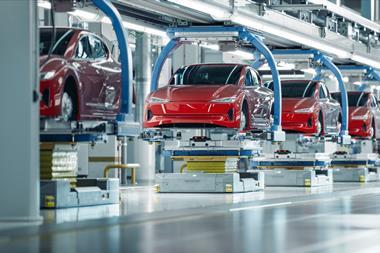We are anticipating a transportation revolution, as electric and autonomous cars hit our roads. But from battery fires sparking concern to liability questions over driverless crashes, the risks are still largely unmapped territory. Matt Scott reports.
The motor industry has been undergoing a technological revolution, with electric vehicles (EVs) growing in popularity and autonomous vehicles growing in viability.
EV sales reached record levels in 2023, while driverless cars are no longer the reserve of science fiction, as they are being tested on the roads of a number of US cities.

But what new risks face automotive manufacturers as a result? And how are they being managed?
FEAR OF FIRE
Sharon Shi, a senior manager for insurance and risk management at BMW-Brilliance Automotive, as well as a PARIMA board member in China, says the main risk difference for EVs versus traditional combustion engines centres around the battery itself.
“We are producing both traditional combustion engine and electric-powered vehicles in our plant,” she says. “The storage and transportation of the batteries is a very new concern within the supply chain. Plus we have to consider the risks created by the batteries once the vehicle is on the road.”
The batteries used in EVs are susceptible to thermal runaway - which causes fires to progress more quickly and more intensely.
But Jon Dye, director of motor underwriting for QBE’s European operations, says that while the speed and severity of such fires would be greater than for traditionally powered vehicles, the insurer is not yet seeing a greater frequency of such events.
“The storage and transportation of the batteries is a very new concern within the supply chain.”
“Electric fires are definitely more severe,” he says. “But the number of electric vehicles on the roads is still relatively small, so there isn’t enough evidence to say that battery fires, from a frequency perspective, are any worse than internal combustion engine vehicles.”
These new batteries are not exempt from more traditional risks, too, however, and Shi says global uncertainty and disruption to international supply chains has caused its own problems for motor manufacturers.
“Batteries are now one of the major components needed by car producers across their whole supply chain. In the last couple of years, there have been various crises that have affected the supply of battery materials. This has caused a number of production difficulties for brands around the world.”
The difference here, however, is that there are fewer battery manufacturers in the market that can supply these components, making the impact much more marked than similar supply chain disruptions affecting the production of internal combustion engine vehicles.
WHO IS LIABLE?
In the autonomous vehicle world, of fundamental concern to motor manufacturers and their customers – as well as the insurers providing cover – is the issue of liability.
“If an autonomous vehicle is in manual mode then the person driving [is liable in the event of a crash] and they would not be able to make a claim against the manufacturer [for any injuries],” Dye says.
“But if a user is in charge of the vehicle in autonomous mode, then they become a third party. So, if that car crashes, they can claim against their motor insurer and then we would subrogate that against the motor manufacturer.”
Insurers need one crucial thing from motor manufacturers – data. “One of the conversations going around is about the availability of data coming out of the vehicle, and what’s available following an accident,” Dye adds.
“We need to have a framework for who is responsible for what, and that is something we are talking about with regulators.”
“We need that to identify whether or not we are potentially paying the driver for any injuries caused to them. It is critical that we get that data at the time of the accident so that we can handle the claims of the injured parties and give them the best service we can.”
And then there is the fear of terrorism - specifically the threat of that autonomous vehicles could have their software hijacked and be taken control of remotely.
“If somebody could hack into a large number of autonomous vehicles at the same time and make them all crash into a single point, that is an additional risk that we don’t have a response to currently,” Dye says.
“At the moment, we don’t have any clarity around who is responsible should that happen. We need to have a framework for who is responsible for what, and that is something we are talking about with regulators.”
YOUR OWN INSURER
Shi says that all these issues are creating a demand for better collaboration between motor manufacturers and the insurance industry than is currently being seen. This need led to BMW establishing its own Chinese insurance broker in November last year, something that Shi says is becoming more commonplace.
“If you look at the past couple of years, there has been a gap between OEMs [original equipment manufacturers] and insurers. There’s an imbalance in transparency between the insurance company and their understanding of what OEMs are doing, and in the end, this will lead to customers being treated unfairly.
“Through our in-house broker, we are able to provide much more transparent information to our insurer, in order to enable better management of the risks”
“This has prompted more motor manufacturers to establish their own insurance intermediaries to better support their core business.”
And Shi says BMW is already seeing the benefits of such an approach. “Through our in-house broker, we are able to provide much more transparent information to our insurer, in order to enable better management of the risks associated with both the production process and the ownership of these new cars,” she says.
This seems like a win-win for those involved, and something other players in the sector will take note of as this market continues to develop.









No comments yet